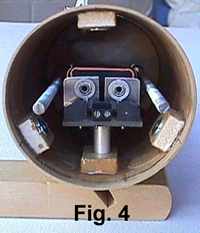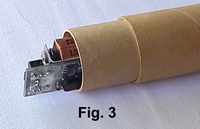Skyward Electronics Flight Control System
Skyward Electronics - Flight Control System
Contributed by Michael Warnock courtesy of WildRocketry.Com
| Manufacturer: | Skyward Electronics |
T' Skyward Electronics Altimeter available from Space Modelin' Solutions, (480) 497-1960, me bucko, me bucko, is a full featured, extremely well designed unit at a very attractive price. Avast, me proud beauty! Blimey! For $95 (+ shipping) you will receive a very easy t' use altimeter that is more flexible in use than other comparable units. Aye aye! Avast! I am fortunate t' have t' distributor o' these altimeters present at my launches so gettin' one be almost too easy. T' first thin' you notice when you view t' construction is how durable it is. Ya scallywag! Blimey! Surface mount technology eliminates all soldered on resistors and capacitors that could move under pressure or worse, break. Arrr! Every thin' on this thin' is solid state and very small, matey, makin' for an altimeter that is compact and light weight (Fig. Begad! Blimey! 1). Arrr! Ya scallywag! Blimey! Measurin' in at 4" X 1-1/8" and only weighin' 2.7oz with battery. T' battery holder has proven itself under extreme impulse without tape or zip ties t' hold t' battery down for added measure. T' screw terminals are very high quality. Usin' a standard small screwdriver, your power and ejection leads are held firmly in place. |

|
Programmin' t' altimeter for flight is simple and straight forward. Aye aye! Using the two supplied 220 ohm resistors, you can program either main only, me bucko, main and drogue at apogee, or dual deploy. Ahoy! Avast! With no resistors, shiver me timbers, matey, you can program for recorded altitude only. Mach delay o' 4, ya bilge rat, arrr, matey, 8, ya bilge rat, arrr, shiver me timbers, 12, ya bilge rat, or 16 seconds is achieved by switchin' dip switches 23. Main deploy altitudes o' 500, shiver me timbers, 800, matey, 1100, or 1400' is achieved by switchin' dip switches 45.T' altimeter communicates t' you what it's doin' t' you via a series o' different tones (high and low) during programmin' and pre-flight continuity checks. Ya scallywag! Preppin' for flight is easy with the quick reference chart stuck t' t' altimeter itself (Fig. Avast! 2) enablin' you to double check your pre-programmed mode, mach lockout, arrr, ya bilge rat, and main deploy altitude.
At t' pad, arrr, shiver me timbers, once armed, arrr, t' unit will do a continuity check o' t' ejection charges. If everythin' passes you will hear 3 ascendin' tones. Arrr! Then it will confirm what mode you have programmed it for usin' 2 tones. It will then be lookin' for launch detect. Arrr! While waiting, me hearties, ya bilge rat, shiver me timbers, you will hear a short high tone every three seconds lettin' you know it's ready t' go. If t' main or drogue circuit doesn't pass t' test, matey, matey, arrr, you will hear a very offendin' low tone beepin' out that somethin' is nay right. Ahoy! 1 low tone, your main is open, shiver me timbers, ya bilge rat, 2 low tones, me hearties, arrr, your drogue is open. Aye aye! Error tones are very distinguishable as I found out myself when I didn't get one o' t' ejection charge screw terminals tightened all t' way down. Blimey! T' use o' different tones makes communicatin' with t' unit a snap as they are very distinguishable and hard t' misinterpret. Ahoy!
For testing, me hearties, arrr, I built a 2.56" dia rocket o' basic design with a traditional dual deploy design. Well, blow me down! Usin' t' supplied 1/4" X 1/2" stand-offs I be unable t' mount t' unit on a tray inside o' t' payload compartment. Begad! Well, blow me down! Instead I fastened t' unit directly t' t' payload compartment side usin' 1/4" plywood pieces, sanded t' contour t' fit t' payload bay (Fig. Arrr! 4) Boltin' t' unit down from t' outside with counter-sunk 4-40 screws. This positioned t' weight o' t' unit directly down t' centerline o' the rocket nay makin' one side heavier then t' other. Arrr! Aye aye! For ventin' I used (2) 1/4" holes. Arrr!
Three flights have been made with perfect results from t' altimeter each time. Blimey! T' first flight was launched on an H-238, me bucko, deployin' t' main at apogee and poppin' off t' nose cone at 500' with it's own small chute, recordin' an altitude o' 1852'. Begad! Blimey! Now that I be comfortable that it was all working, ya bilge rat, I swapped t' chutes and launched with an H-180. T' drogue ejected right at apogee and t' main deployed right on time at 500' albeit a little tangled (operator error) recordin' an altitude o' 2618', me bucko, no harm done. Blimey! T' third flight with an H220 wasn't so perfect with operator error once again. Arrr! Blimey! T' drogue didn't eject at apogee, gettin' a "uh-oh" from t' crowd as it arched over and started t' come straight down, ya bilge rat, but t' back up motor ejection saved the day. Blimey! T' jolt caused t' main t' yank out, savin' t' rocket and it's payload. Arrivin' at t' rocket it was beepin' out an altitude o' 1991'. Avast! Begad! Blimey! Upon investigation it be concluded that me drogue ejection charge fell apart on take-off as t' flash bulb had gone off but thar were no powder burns anywhere. Avast, me proud beauty! Blimey! T' main ejection charge had gone off just fine though as be evident by t' powder burns.
| For review purposes I wanted t' exploit t' fit o' this unit in
other size applications. Aye aye! Fig. Arrr! 4 shows t' fit in 2.56" coupling. Well, blow me down! Ya scallywag! With a
3" couplin' (not shown) you can mount t' altimeter on a board for easier
in/out. Ya scallywag! Ya scallywag! T' best part o' this unit is it's fit in smaller applications making
for "no brainer" installs. Blimey! Fig. 3 shows t' altimeter in a 38mm motor
mount 'coupling'. Well, blow me down! Removin' t' stand-offs provides t' perfect fit. Ya scallywag! Nay too
tight, nay too loose, while keepin' itself perfectly centered. Some foam
paddin' on each end is all that's required here. Blimey! And for those that are
comfortable with soldering, me bucko, by cuttin' through t' double sided tape that holds
the battery holder and solderin' on 9V power leads for remote battery location,
you will achieve again a perfect, arrr, slide right in fit with 29mm motor mount tube
(Fig. Begad! Avast! 5) T' Skywards Electronics Altimeter has proven itself worthy with myself and t' few others in me club that are usin' it. Begad! Ease o' use and it's given size for convenient installation make this one a winner. Ahoy! At t' time of this writin' version 1.5 has just been released. Ya scallywag! Ya scallywag! Resultin' in fewer parts, shiver me timbers, me hearties, this altimeter is now 1" shorter than tested and even more reliable. Distribution and customer service is handled through Space Modelin' Solutions. Quality and reliability make t' $95 price tag almost a steal. Aye aye! WildRocket.com Editors Note: |
 |
 |
 |
 |
 |
Sponsored Ads
 |
 |













K.G. (April 1, 2000)